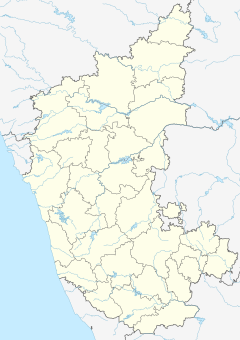Yellamma Temple, Saundatti
| Renuka Yellamma Temple ರೇಣುಕ ಯಲ್ಲಮ್ಮ ದೇವಿ ದೇವಸ್ಥಾನ | |
|---|---|

Renuka Temple, Saundatti
|
|
| Geography | |
| Coordinates | 15°45′14″N 75°09′36″E / 15.754°N 75.16°ECoordinates: 15°45′14″N 75°09′36″E / 15.754°N 75.16°E |
| Country | India |
| State | Karnataka |
| District | Belgaum |
| Location | Saundatti |
| Culture | |
| Sanctum | Yellamma or Renuka |
| Architecture | |
| Architectural styles | Jain architecture of the Chalukya and Rashtrakuta Style |
| Number of temples | 1 |
| History and governance | |
| Date built | 1514 |
| Creator | Bomappa Naik of Raybag |
Yellamma Temple, also known as Renuka Temple,Kannada in ರೇಣುಕ ಯಲ್ಲಮ್ಮ ದೇವಿ ದೇವಸ್ಥಾನ is a pilgrimage destination located about 5 kilometres (3.1 mi) away from the town of Saundatti in the Indian state of Karnataka. It is situated on a hilltop known earlier as Siddhachal Parvat and now known as "Yellamma Gudi", named after the temple. The deity in the temple is the goddess Yellamma or Ellama or Renuka, revered as a fertility goddess. The temple is associated with the ancient Devadasi practice of dedicating girls to the temple, which the Government of Karnataka claims to have eliminated. The hill, a part of the Sidhachal or Ramagiri hill range which overlooks the Malaprabha river, contains archaeological evidences of occupation dating to the mid-8th to mid-11th centuries of the early Rashtrakuta or late Chalukyan period, and includes megalithic tombs which predate these periods.
The hill on which the Yellamma Temple sits is part of the Sidhachal or Ramagiri range, oriented east-west and overlooking the Malaprabha river near the town of Saundatti. While the temple 5 kilometres (3.1 mi) away from the town, the town itself is 112 kilometres (70 mi) away from Belgaum, the district headquarters. Dharwar and Hubli are two other major towns which are at a distance of 38 kilometres (24 mi) and 58 kilometres (36 mi) respectively from Saundatti.
The temple was built in 1514 by Bomappa Naik of Raybag. According to archaeological evidence found around the temple, a temple existed here either during the early Rashtrakuta or late Chalukyan period from the mid-8th to the mid-11th centuries. The megalithic tombs found here are dated to a much earlier period. Also seen on the hill are potsherds of early historic redware dated to the 3rd century BC to the 3rd century AD, in addition to megalithic blackware and redware. It is believed that the Yellamma fertility cult was prevalent here even during the Chalukyan period, following their taking possession of this region from the Kadambas of Banavasi.
...
Wikipedia

